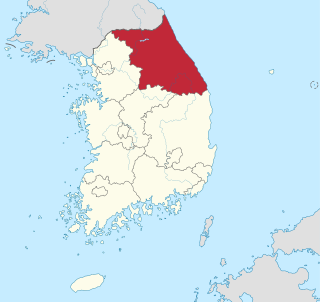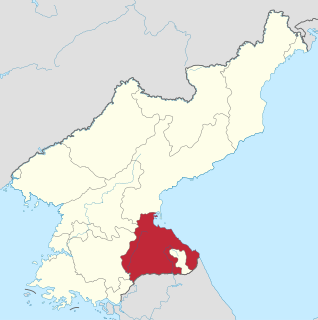
South Korea, officially the Republic of Korea (ROK), is a country in East Asia, constituting the southern part of the Korean Peninsula. The name Korea is derived from Goguryeo which was one of the great powers in East Asia during its time, ruling most of the Korean Peninsula, Manchuria, parts of the Russian Far East and Inner Mongolia under Gwanggaeto the Great. Its capital, Seoul, is a major global city and half of South Korea's 51 million people live in the Seoul Capital Area, the fourth largest metropolitan economy in the world.
ISO 3166-2:KP is the entry for North Korea in ISO 3166-2, part of the ISO 3166 standard published by the International Organization for Standardization (ISO), which defines codes for the names of the principal subdivisions of all countries coded in ISO 3166-1.

Yanbian is an autonomous prefecture in northeastern Jilin Province, China. Yanbian is bordered to the north by Heilongjiang, on the west by Baishan and Jilin City, on the south by North Hamgyong Province of North Korea, and on the east by Primorsky Krai of Russia. Yanbian is designated as the Korean autonomous prefecture due to the large number of ethnic Koreans living in the region. The prefectural capital is Yanji, and the total area is 42,700 square kilometres (16,500 sq mi).

Gangwon-do is a province of South Korea, with its capital at Chuncheon. It is bounded on the east part by the Sea of Japan, and borders Gyeonggi Province to its west, and North Gyeongsang Province and North Chungcheong Province to its south. Its northern boundary is the Military Demarcation Line, separating it from North Korea's Kangwŏn Province. Before the division of Korea in 1945 Gangwon and Kangwŏn formed a single province. Pyeongchang County hosted the 2018 Winter Olympics and 2018 Winter Paralympics.

North Jeolla Province or Jeollabuk-do is a province in the southwest of South Korea. The province was formed in 1896 from the northern half of the former Jeolla province, and remained a province of Korea until the country's division in 1945, then became part of South Korea. The provincial capital is Jeonju, which was the capital of all of Jeolla before 1896.

Gyeonggi-do is the most populous province in South Korea. Its name, Gyeonggi means "the area surrounding the capital". Thus Gyeonggi-do can be translated as "province surrounding Seoul". The provincial capital is Suwon. Seoul—South Korea's largest city and national capital—is in the heart of the province but has been separately administered as a provincial-level special city since 1946. Incheon—South Korea's third-largest city—is on the coast of the province and has been similarly administered as a provincial-level metropolitan city since 1981. The three jurisdictions are collectively referred to as Sudogwon and cover 11,730 km2 (4,530 sq mi), with a combined population of 25.5 million—amounting to over half of the entire population of South Korea.

Gyeongsang was one of the eight provinces of Korea during the Joseon dynasty. Gyeongsang was located in the southeast of Korea.

Kangwon Province is a province of North Korea, with its capital at Wŏnsan. Before the division of Korea in 1945, Kangwŏn Province and its South Korean neighbour Gangwon Province formed a single province that excluded Wŏnsan.

Kaesong is a city in North Hwanghae Province in the southern part of North Korea, a former Directly Governed City and the capital of Korea during the Taebong kingdom and subsequent Goryeo dynasty. The city is near the Kaesong Industrial Region close to the border with South Korea and contains the remains of the Manwoldae palace. Called Songdo while it was the ancient capital of Goryeo, the city prospered as a trade centre that produced Korean ginseng. Kaesong now functions as the DPRK's light industry centre.

Pyeongchang is a county in the province of Gangwon-do, South Korea, located in the Taebaek Mountains region. It is home to several Buddhist temples, including Woljeongsa. It is about 180 km (110 mi) east southeast of Seoul, the capital of South Korea, and connected by expressways and high-speed passenger railways. Pyeongchang's slogan, "Happy 700 Pyeongchang", is taken from its average elevation of approximately 700 metres (2,300 ft).
Yeongnam is a region that coincides with the former Gyeongsang Province in what is now South Korea.

Terms such as Northeast Asia, North East Asia or Northeastern Asia, refer to a subregion of Asia: the northeastern landmass and islands, bordering the Pacific Ocean. It includes the core countries of East Asia.

Northeast China or Dongbei is a geographical region of China. It also historically corresponds with the term Inner Manchuria in the English language. It consists specifically of the three provinces of Liaoning, Jilin, and Heilongjiang, collectively referred as the Three Northeastern Provinces (东北三省), but broadly also encompasses the eastern part of Inner Mongolia. The region is separated from Far Eastern Russia to the north largely by the Amur, Argun, and Ussuri rivers, from North Korea to the south by the Yalu River and Tumen River, and from the Inner Mongolian Autonomous Region to the west by the Greater Khingan Range. The heartland of the region is the Northeast China Plain.

A number of Korean dialects are spoken in the Korean Peninsula. The peninsula is extremely mountainous and each dialect's "territory" corresponds closely to the natural boundaries between different geographical regions of Korea. Most of the dialects are named for one of the traditional Eight Provinces of Korea. One is sufficiently distinct from the others to be considered a separate language, the Jeju language.

The Kaesong Industrial Region (KIR) or Kaesong Industrial Zone (KIZ) is a special administrative industrial region of North Korea (DPRK). It was formed in 2002 from part of the Kaesong Directly-Governed City. On 10 February 2016, it was temporarily closed by the South Korean government and all staff recalled by the Park Geun-hye administration, although the incumbent President of South Korea, Moon Jae-in, has signalled his desire to "reopen and expand" the region.

DVD region codes are a digital rights management technique designed to allow rights holders to control the international distribution of a DVD release, including its content, release date, and price, all according to the appropriate region.

East Asia is the eastern subregion of Asia, defined in either geographical or ethno-cultural terms. China, Japan, Korea, and Vietnam belong to the East Asian cultural sphere. Geographically and geopolitically, the region includes China, Hong Kong, Macau, Taiwan, Japan, Mongolia, North Korea, and South Korea.

The Seoul Capital Area (SCA), Sudogwon or Gyeonggi region is the metropolitan area of Seoul, Incheon, and Gyeonggi-do located in north-west South Korea. It has a population of 25 million and is ranked as the fifth largest metropolitan area in the world. Its area is about 11,704 km2 (4,519 sq mi). It forms the cultural, commercial, financial, industrial, and residential center of South Korea. The largest city is Seoul, with a population of approximately 10 million people, followed by Incheon, with 3 million inhabitants.

The Consulate General of South Korea for Southern India is one of the missions of South Korea in India focusing on Korean interests in the region. It is located in Chennai and its jurisdiction includes the states of Tamil Nadu, Karnataka, Kerala and the union territory of Puducherry. The other South Korean missions in the India is the Embassy of the Republic of Korea at New Delhi and the Consulate General of the Republic of Korea in Mumbai, in addition to an honorary consulate office in Kolkata. The current consul general of the Chennai Consulate is Kim Hyung Tae. He was preceded by Kyungsoo Kim, the first consul general of the Chennai Consulate and the first head of mission since the establishment of the Mission in 2014.



















